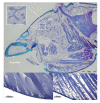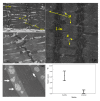Behavioral mechanisms and morphological symptoms of zombie ants dying from fungal infection
- PMID: 21554670
- PMCID: PMC3118224
- DOI: 10.1186/1472-6785-11-13
Behavioral mechanisms and morphological symptoms of zombie ants dying from fungal infection
Abstract
Background: Parasites that manipulate host behavior can provide prominent examples of extended phenotypes: parasite genomes controlling host behavior. Here we focus on one of the most dramatic examples of behavioral manipulation, the death grip of ants infected by Ophiocordyceps fungi. We studied the interaction between O. unilateralis s.l. and its host ant Camponotus leonardi in a Thai rainforest, where infected ants descend from their canopy nests down to understory vegetation to bite into abaxial leaf veins before dying. Host mortality is concentrated in patches (graveyards) where ants die on sapling leaves ca. 25 cm above the soil surface where conditions for parasite development are optimal. Here we address whether the sequence of ant behaviors leading to the final death grip can also be interpreted as parasite adaptations and describe some of the morphological changes inside the heads of infected workers that mediate the expression of the death grip phenotype.
Results: We found that infected ants behave as zombies and display predictable stereotypical behaviors of random rather than directional walking, and of repeated convulsions that make them fall down and thus precludes returning to the canopy. Transitions from erratic wandering to death grips on a leaf vein were abrupt and synchronized around solar noon. We show that the mandibles of ants penetrate deeply into vein tissue and that this is accompanied by extensive atrophy of the mandibular muscles. This lock-jaw means the ant will remain attached to the leaf after death. We further present histological data to show that a high density of single celled stages of the parasite within the head capsule of dying ants are likely to be responsible for this muscular atrophy.
Conclusions: Extended phenotypes in ants induced by fungal infections are a complex example of behavioral manipulation requiring coordinated changes of host behavior and morphology. Future work should address the genetic basis of such extended phenotypes.
Figures





Similar articles
-
Zombie ant death grip due to hypercontracted mandibular muscles.J Exp Biol. 2019 Jul 17;222(Pt 14):jeb200683. doi: 10.1242/jeb.200683. J Exp Biol. 2019. PMID: 31315924 Free PMC article.
-
The life of a dead ant: the expression of an adaptive extended phenotype.Am Nat. 2009 Sep;174(3):424-33. doi: 10.1086/603640. Am Nat. 2009. PMID: 19627240
-
Zombie-Ant Fungi Emerged from Non-manipulating, Beetle-Infecting Ancestors.Curr Biol. 2019 Nov 4;29(21):3735-3738.e2. doi: 10.1016/j.cub.2019.09.004. Epub 2019 Oct 24. Curr Biol. 2019. PMID: 31668622
-
Ophiocordyceps-ant interactions as an integrative model to understand the molecular basis of parasitic behavioral manipulation.Curr Opin Insect Sci. 2019 Jun;33:19-24. doi: 10.1016/j.cois.2019.01.005. Epub 2019 Jan 17. Curr Opin Insect Sci. 2019. PMID: 31358190 Review.
-
Mechanisms Underlying Ophiocordyceps Infection and Behavioral Manipulation of Ants: Unique or Ubiquitous?Annu Rev Microbiol. 2024 Nov;78(1):575-593. doi: 10.1146/annurev-micro-041522-092522. Epub 2024 Nov 7. Annu Rev Microbiol. 2024. PMID: 39270680 Review.
Cited by
-
Molecular Rationale of Insect-Microbes Symbiosis-From Insect Behaviour to Mechanism.Microorganisms. 2021 Nov 24;9(12):2422. doi: 10.3390/microorganisms9122422. Microorganisms. 2021. PMID: 34946024 Free PMC article. Review.
-
Position of larval tapeworms, Polypocephalus sp., in the ganglia of shrimp, Litopenaeus setiferus.Integr Comp Biol. 2014 Jul;54(2):143-8. doi: 10.1093/icb/icu043. Epub 2014 May 11. Integr Comp Biol. 2014. PMID: 24820854 Free PMC article.
-
Reduced Environmental Microbial Diversity on the Cuticle and in the Galleries of a Subterranean Termite Compared to Surrounding Soil.Microb Ecol. 2021 May;81(4):1054-1063. doi: 10.1007/s00248-020-01664-w. Epub 2021 Jan 5. Microb Ecol. 2021. PMID: 33399932
-
Entomopathogenic fungi: insights into recent understanding.World J Microbiol Biotechnol. 2025 May 26;41(6):179. doi: 10.1007/s11274-025-04377-9. World J Microbiol Biotechnol. 2025. PMID: 40415063 Review.
-
Evidence that Entomophthora muscae controls the timing of host death via its own circadian clock.bioRxiv [Preprint]. 2025 Jun 18:2025.06.18.660419. doi: 10.1101/2025.06.18.660419. bioRxiv. 2025. PMID: 40666906 Free PMC article. Preprint.
References
-
- Moore J. Parasites and the behavior of animals. Oxford: Oxford University Press; 2002.
-
- Poulin R. Progenesis and reduced virulence as an alternative transmission strategy in a parasitic trematode. Parasitology. 2001;123:623–630. - PubMed
-
- Lefevre T, Adamo SA, Biron DG, Misse D, Hughes D, Thomas F. Invasion of the Body Snatchers: the diversity and evolution of manipulative strategies in host-parasite interactions. Advances in Parasitology. 2009;68:45–83. - PubMed
-
- Dawkins R. The extended phenotype. Oxford: W.H. Freeman; 1982.
Publication types
MeSH terms
LinkOut - more resources
Full Text Sources

